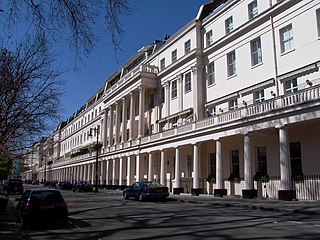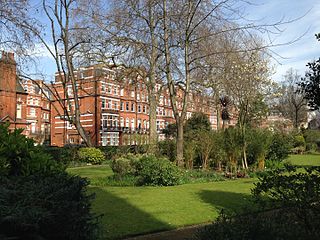
Phillimore Gardens is a street in Kensington, West London, England.
Contents
Phillimore Gardens runs roughly north to south from Duchess of Bedford's Walk to Kensington High Street. The houses on the west side all back on to Holland Park.

Phillimore Gardens is a street in Kensington, West London, England.
Phillimore Gardens runs roughly north to south from Duchess of Bedford's Walk to Kensington High Street. The houses on the west side all back on to Holland Park.
The road was built on the Phillimore Estate, on land acquired by the Phillimore family in the early 18th century, and much of which is still owned by them. [1] Speculative building began within 10 years of William Phillimore succeeding to the estate in 1779. [1]
In 2014, one of the 10 most expensive houses sold in London, at £19.75m, was on the street. [2]
In 2022, it was the most expensive street in England, with an average house price of £23.8m, according to Halifax. [3]

Kensington is an area of London in the Royal Borough of Kensington and Chelsea, around 2.9 miles (4.6 km) west of Central London.
Earl's Court is a district of Kensington in the Royal Borough of Kensington and Chelsea in West London, bordering the rail tracks of the West London line and District line that separate it from the ancient borough of Fulham to the west, the sub-districts of South Kensington to the east, Chelsea to the south and Kensington to the northeast. It lent its name to the now defunct eponymous pleasure grounds opened in 1887 followed by the pre–World War II Earls Court Exhibition Centre, as one of the country's largest indoor arenas and a popular concert venue, until its closure in 2014.

Berkeley Square is a garden square in the West End of London. It is one of the best known of the many squares in London, located in Mayfair in the City of Westminster. It was laid out in the mid 18th century by the architect William Kent, and originally extended further south. The garden's very large London Plane trees are among the oldest in central London, planted in 1789.

Holland Park is an area of Kensington, on the western edge of Central London, that lies within the Royal Borough of Chelsea and Kensington, and largely surrounds its namesake park, Holland Park. It has no official boundaries but is roughly bounded by Kensington High Street to the south, Holland Road to the west, Holland Park Avenue to the north, and Kensington Church Street to the east. In reality, the Holland Park district extends north of Holland Park Avenue, toward Notting Hill. It has been said that Holland Park is the “posh” part of Notting Hill. The three principal neighbourhoods of Holland Park are centred around the Park itself, with stately houses and townhomes to the north, south and west of the Park. Adjacent districts are Notting Hill to the north, Earl's Court to the south, and Shepherd's Bush to the west.

Eaton Square is a rectangular, residential garden square in London's Belgravia district. It is the largest square in London. It is one of the three squares built by the landowning Grosvenor family when they developed the main part of Belgravia in the 19th century that are named after places in Cheshire — in this case Eaton Hall, the Grosvenor country house. It is larger but less grand than the central feature of the district, Belgrave Square, and both larger and grander than Chester Square. The first block was laid out by Thomas Cubitt from 1827. In 2016 it was named as the "Most Expensive Place to Buy Property in Britain", with a full terraced house costing on average £17 million — many of such town houses have been converted, within the same, protected structures, into upmarket apartments.
West Kensington, formerly North End, is an area in the ancient parish of Fulham, in the London Borough of Hammersmith and Fulham, England, 3.4 miles (5.5 km) west of Charing Cross. It covers most of the London postal area of W14, including the area around Barons Court tube station, and is defined as the area between Lillie Road and Hammersmith Road to the west, Fulham Palace Road to the south, Hammersmith to the north and West Brompton and Earl's Court to the east. The area is bisected by the major London artery the A4, locally known as the Talgarth Road. Its main local thoroughfare is the North End Road.
Events from the year 1811 in the United Kingdom. This is a census year and the start of the British Regency.

Englefield House is an Elizabethan country house with surrounding estate at Englefield in the English county of Berkshire. The gardens are open to the public all year round on particular weekdays and the house by appointment only for large groups.

Campden Hill is a hill in Kensington, West London, bounded by Holland Park Avenue on the north, Kensington High Street on the south, Kensington Palace Gardens on the east and Abbotsbury Road on the west. The name derives from the former Campden House, built by Baptist Hicks, 1st Viscount Campden whose country seat was Campden House in the Gloucestershire town of Chipping Campden.

Admiral Sir William Hutcheon Hall,, was a British Royal Navy officer. He served in the First Anglo-Chinese War and Crimean War. He was one of the first British officers to make a thorough study of steam engines. In China, he commanded the iron steamship Nemesis of the East India Company. Although it was not officially commissioned as a Royal Navy warship, the Admiralty enabled Hall to count his time in the Nemesis as if he had served in one of Her Majesty's Ships.

The Bedford Estate is an estate in central London owned by the Russell family, which holds the peerage title of Duke of Bedford. The estate was originally based in Covent Garden, then stretched to include Bloomsbury in 1669. The Covent Garden property was sold for £2 million in 1913 by Herbrand Russell, 11th Duke of Bedford, to the MP and land speculator Harry Mallaby-Deeley, who sold his option to the Beecham family for £250,000; the sale was finalised in 1918.

Onslow Square is a garden square in South Kensington, London, England.

Addison Road is a road in London, England, which connects Kensington High Street with Notting Hill and Holland Park Avenue, and runs nearby to Holland Park.

Holland House, originally known as Cope Castle, was an early Jacobean country house in Kensington, London, situated in a country estate that is now Holland Park. It was built in 1605 by the diplomat Sir Walter Cope. The building later passed by marriage to Henry Rich, 1st Baron Kensington, 1st Earl of Holland, and by descent through the Rich family, then became the property of the Fox family, during which time it became a noted gathering-place for Whigs in the 19th century. The house was largely destroyed by German firebombing during the Blitz in 1940 and today only the east wing and some ruins of the ground floor and south facade remain, along with various outbuildings and formal gardens. In 1949 the ruin was designated a grade I listed building and it is now owned by the Royal Borough of Kensington and Chelsea.

De Vere Gardens is a street in Kensington, London, that in 2015 was considered the fifth most expensive street in England.

Hornton Street is a street in Kensington, London W8. It runs north to south from Sheffield Terrace to Kensington High Street.

Campden Hill Road is a street in Kensington, London W8. It runs north to south from Notting Hill Gate to Kensington High Street.

Egerton Gardens is a street and communal garden, regionally termed a garden square, in South Kensington, London SW3.

Phillimore Place is a street in Kensington, London.

Ilchester Place is a street in the Holland Park area of Kensington, West London, England.